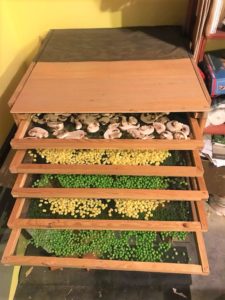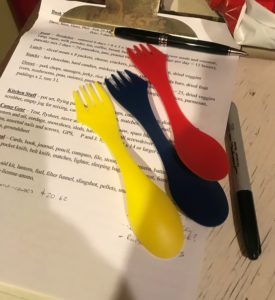I’ve been winter-camping in Canada’s shield-forest for about 40 years — many, many trips. In fact in recent decades I’ve snowshoed more than I’ve paddled due to other summer commitments (sailboats and Spitfires). I learned how to winter-travel from a friend of mine, JP Masse, in the 1980s; he learned this traditional way of bush-living from a trapper uncle near Val D’Or, long ago. It’s NOT survival. It’s more informed than that — it’s wilderness living, in winter.
I’ve nearly always used a wall-tent, which was custom-made to my own specs. It’s an 8 x 10, and weighs 14 pounds. In combination with a small light wood-burning stove, camp-life is warm and dry and very pleasant.

So in Feb 2020, I gathered things up again, prepped and packed, for 5 of us to go North. The Plan was a 9-day journey, NW of Sudbury. We’d drop off the Budd Car (the Sudbury-White River train) (which has nothing whatsoever to do with Budweiser beer) at a particular mileage (not a station at all), and then flag it down later to get picked up.
We’d be hauling all our gear on sleds. So lightness counted — human beings are lousy sled-pullers. I dried much of the food at home. This dehydrator came from the book “Dry It, You’ll Like It”, except I used an old electric frying pan as the heat source. [click on photos to expand]
Endless trips to town, with lists, preparing for 5 guys for 10 days…
A truck is enormously handy for supporting my way of life. Hans arrived to help me load up.
The all-time best way to get into the Bush from Southern Ontario is the “Budd Car”, the Sudbury-White River train service. It goes up the track one day, back the next, takes Monday off, and you can drop-off, or flag it down and get picked up, absolutely anywhere — it doesn’t have to be a station. So we drove up the night before, stayed in a hotel, and were in place for the 09:00 departure next morning.
What a tremendous way to get into a wilderness! You’re off the roads, away from the ski-doo networks, beyond cellphone service or internet, and you travel in classic comfort — it’s like stepping back to 1965.  Where did we go? I’m not telling! (But it wasn’t a Park.) I picked a beautiful chain of lakes off the map in Crown Land (which I own, being a Canadian citizen). Then I contacted MNR to make sure it wasn’t being logged this season. And measured off the track-mileage. When we got on board, I said we wanted to get off at “Mile XXX”, and the engineer figured it out. (We had to buy a ticket to the next whistle-stop, but it’s all very cheap.) In a few hours (right on sched) the train drew to a halt beside a lake, we jumped down into the snow, they handed us our sleds and gear…
Where did we go? I’m not telling! (But it wasn’t a Park.) I picked a beautiful chain of lakes off the map in Crown Land (which I own, being a Canadian citizen). Then I contacted MNR to make sure it wasn’t being logged this season. And measured off the track-mileage. When we got on board, I said we wanted to get off at “Mile XXX”, and the engineer figured it out. (We had to buy a ticket to the next whistle-stop, but it’s all very cheap.) In a few hours (right on sched) the train drew to a halt beside a lake, we jumped down into the snow, they handed us our sleds and gear… 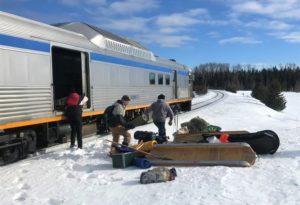 …and off it went, leaving us standing happily in the middle of… everywhere.
…and off it went, leaving us standing happily in the middle of… everywhere.  Stowing the apparent mountain of gear was easy with 5 of us!
Stowing the apparent mountain of gear was easy with 5 of us!  Each person hauled their own stuff, plus their share of the camp gear and food — not much, spread out like that. But the GIANT question is always: what’s the ice like? Is it crusty and easy to pull on, or 2 ft of soft powder? Is there slush under the snow, to trap your snowshoes and force you off the open lake? Will you have to go up-and-back before you can pull the load? Luck was with us!
Each person hauled their own stuff, plus their share of the camp gear and food — not much, spread out like that. But the GIANT question is always: what’s the ice like? Is it crusty and easy to pull on, or 2 ft of soft powder? Is there slush under the snow, to trap your snowshoes and force you off the open lake? Will you have to go up-and-back before you can pull the load? Luck was with us! 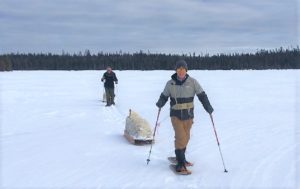 The sleds pulled easily — I was able to haul my 2 Pelican sleds and break trail at the same time. But there were some soft-looking spots in the ice: seeps and “Otter Holes”. The snow was much deeper than last time we were up here — 2-3 ft in the bush, pressing down the ice, bringing up slush in certain areas. At 2 channels I suspected that currents had thinned the ice too much, so made portages across the necks of land.
The sleds pulled easily — I was able to haul my 2 Pelican sleds and break trail at the same time. But there were some soft-looking spots in the ice: seeps and “Otter Holes”. The snow was much deeper than last time we were up here — 2-3 ft in the bush, pressing down the ice, bringing up slush in certain areas. At 2 channels I suspected that currents had thinned the ice too much, so made portages across the necks of land.
But all went well. We camped a couple of hours away. A quick set-up for one night was all we needed. I simply wired the stove to 2 sticks set on the snow.
 That little rectangle of Typar spreads out and stops the melt-under. The slits go over the stove-poles.
That little rectangle of Typar spreads out and stops the melt-under. The slits go over the stove-poles. We use the Typar as a ground-sheet, too. It’s vastly better than a plastic tarp: warmer, quieter, doesn’t slide around, lightweight, folds small, and is waterproof enough.
We use the Typar as a ground-sheet, too. It’s vastly better than a plastic tarp: warmer, quieter, doesn’t slide around, lightweight, folds small, and is waterproof enough. 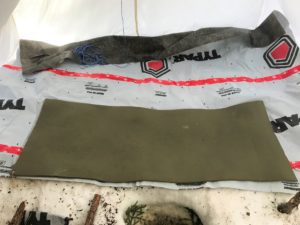 It wasn’t too cold on this trip — about -17C this night. All of us enjoyed the feeling of being away, and having a whole week or more with no emails or calls or business — just a beautiful lake in a beautiful land to explore. Breakfast was cheerful in the bright morning tent…
It wasn’t too cold on this trip — about -17C this night. All of us enjoyed the feeling of being away, and having a whole week or more with no emails or calls or business — just a beautiful lake in a beautiful land to explore. Breakfast was cheerful in the bright morning tent… 
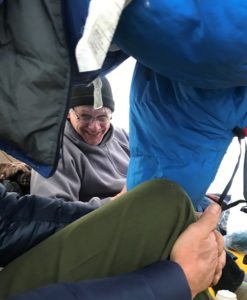 …and standard: oatmeal with pecans and coconut added-in, and a package of pre-cooked bacon.
…and standard: oatmeal with pecans and coconut added-in, and a package of pre-cooked bacon.
Here are the stove-logs in the morning: cut green, they don’t burn through in one night… 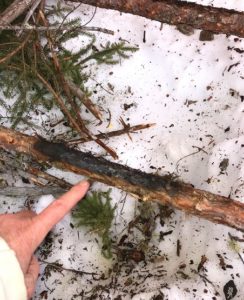 …but for a longer stay I have spacers I slide under the stove onto the logs.
…but for a longer stay I have spacers I slide under the stove onto the logs.
On the trail in good time, we only had to walk a couple of hours to a spot we had marked out on a previous trip: a lovely protected bay with a slope behind us FILLED with dead dry standing spruce. Nirvana for a wall-tent camp! We found the poles where we’d stashed them on a previous camp there several years ago, and re-used them. 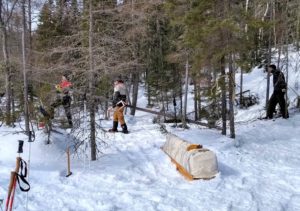 It’s so great to have 5 guys doing the work! A wall-tent camp goes up quick! Note: nearly all my camps in recent years have been one-pole sets. I look for a spot in the bush (NOT in the open) where I can bridge between 2 trees for the ridgepole, and tie the sides out to bushes and whatnot. We made 5 camps in this 9-day trip, and setting-up and taking-down a simple set-up like this was never onerous. Besides, a one-pole-set is easier on the forest, although we choose the ridgepole from a clump of trees where obviously not all can live to maturity.
It’s so great to have 5 guys doing the work! A wall-tent camp goes up quick! Note: nearly all my camps in recent years have been one-pole sets. I look for a spot in the bush (NOT in the open) where I can bridge between 2 trees for the ridgepole, and tie the sides out to bushes and whatnot. We made 5 camps in this 9-day trip, and setting-up and taking-down a simple set-up like this was never onerous. Besides, a one-pole-set is easier on the forest, although we choose the ridgepole from a clump of trees where obviously not all can live to maturity. 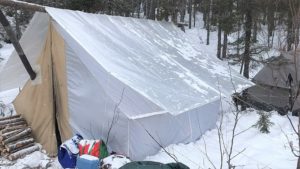 We were all pilots on this trip, so of course talked continuously about our Relationships (relationships with Lycomings, Continentals, Boeings, Airbus, airline managers, taildraggers, Spitfires, etc…). Great wall-tent conversations!
We were all pilots on this trip, so of course talked continuously about our Relationships (relationships with Lycomings, Continentals, Boeings, Airbus, airline managers, taildraggers, Spitfires, etc…). Great wall-tent conversations!  A very congenial group. We stayed in this lovely spot for several days, for day-hikes and exploring.
A very congenial group. We stayed in this lovely spot for several days, for day-hikes and exploring.  Even fed frozen minnows to the denizens below… but with no luck.
Even fed frozen minnows to the denizens below… but with no luck. 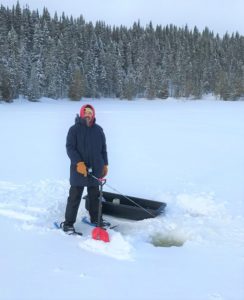 (It’s hard to ice-fish successfully when you have no idea what the lake-depths are, and you have no power-auger. Our sharp ice-chisel works well and is a reasonable compromise, but the ice was 18″ thick, and the wind was cold and continuous.)
(It’s hard to ice-fish successfully when you have no idea what the lake-depths are, and you have no power-auger. Our sharp ice-chisel works well and is a reasonable compromise, but the ice was 18″ thick, and the wind was cold and continuous.)
In fact those first 3 days were the coldest of the trip: -15C during the days, -25C at night, and windy. Not a problem — we’ve had colder in the past — but not all of us could fit in the Wall Tent at night (3 is a comfortable fit). We brought along a dome-tent, and took our turns sleeping there.  The mornings are chilly when you wake up in one, and it sure is nice to scurry over into the warmth of the hot tent for breakfast (And to hang your sleeping bags up to dry.) No one liked the dome-tent, but the one positive aspect was the reduced snoring! And the dawn view in this photo…
The mornings are chilly when you wake up in one, and it sure is nice to scurry over into the warmth of the hot tent for breakfast (And to hang your sleeping bags up to dry.) No one liked the dome-tent, but the one positive aspect was the reduced snoring! And the dawn view in this photo… 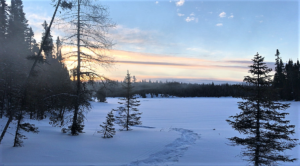 …showed the stove-smoke spreading mistily across the lake in an inversion-layer.
…showed the stove-smoke spreading mistily across the lake in an inversion-layer.
Happiness is a wood-stove in winter. It’s the key to pleasant living on these trips. 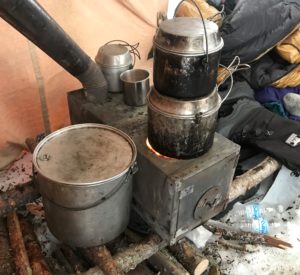 I built this one (as per the directions in this article http://hadfield.ca/the-wood-stove/ ), and it’s sized just-right for an 8×10 tent, and cooking for 4-5 people. It weighs 11 pounds including the pipe — which stores inside the stove for transport ( a big plus). In this typical breakfast photo, the big pail is being used to melt snow — it’s sitting on one rail so it leans against the stove. The middle-sized pot has boiled, and now has tea in it, so the larger pot is set on the open stove-ring, with the teapot on top to keep warm. Farther back, someone’s mug is warming (plastic mugs are a disappointment on a wood stove) and the oatmeal-pot has been re-filled with water for washing-up. These old pots with bail-handles are perfect. Modern ones tend to be wide and shallow with handles that melt: much inferior.
I built this one (as per the directions in this article http://hadfield.ca/the-wood-stove/ ), and it’s sized just-right for an 8×10 tent, and cooking for 4-5 people. It weighs 11 pounds including the pipe — which stores inside the stove for transport ( a big plus). In this typical breakfast photo, the big pail is being used to melt snow — it’s sitting on one rail so it leans against the stove. The middle-sized pot has boiled, and now has tea in it, so the larger pot is set on the open stove-ring, with the teapot on top to keep warm. Farther back, someone’s mug is warming (plastic mugs are a disappointment on a wood stove) and the oatmeal-pot has been re-filled with water for washing-up. These old pots with bail-handles are perfect. Modern ones tend to be wide and shallow with handles that melt: much inferior.
 Having a stove-ring cutout is a BIG advantage with these stoves. With the pot immersed into the firebox, you can boil water as quickly as at home in your kitchen. Most bought-stoves don’t have this feature, and they’re not as good. Meals are slower and later — they can’t not be. New winter campers tend to think that a stove-ring will make the stove smoke-up your tent. FALSE! The draw is inward, into the firebox. In the above photo, a fire of dry hard spruce has made the side glow red-hot. It’s thawing the pork chops, boiling lots of water, cooking dinner, and 4 guys are basking in its heat. In fact, you have to watch your boots and gloves to make sure they don’t melt. There is no way I would have a wood-stove along on a wandering trip like this if it didn’t have a cut-out for a pot-immersion. BTW — we don’t take any other kind of cooking device. NO GAS STOVE. Once you get educated and tuned-in to a wood-stove with a pot cut-out, it becomes so simple and reliable that the idea of a petroleum stove is ridiculous. Also, the stove-lid is handy as a temperature moderator when set on the solid surface of the stove — a simmer-plate.
Having a stove-ring cutout is a BIG advantage with these stoves. With the pot immersed into the firebox, you can boil water as quickly as at home in your kitchen. Most bought-stoves don’t have this feature, and they’re not as good. Meals are slower and later — they can’t not be. New winter campers tend to think that a stove-ring will make the stove smoke-up your tent. FALSE! The draw is inward, into the firebox. In the above photo, a fire of dry hard spruce has made the side glow red-hot. It’s thawing the pork chops, boiling lots of water, cooking dinner, and 4 guys are basking in its heat. In fact, you have to watch your boots and gloves to make sure they don’t melt. There is no way I would have a wood-stove along on a wandering trip like this if it didn’t have a cut-out for a pot-immersion. BTW — we don’t take any other kind of cooking device. NO GAS STOVE. Once you get educated and tuned-in to a wood-stove with a pot cut-out, it becomes so simple and reliable that the idea of a petroleum stove is ridiculous. Also, the stove-lid is handy as a temperature moderator when set on the solid surface of the stove — a simmer-plate.
Pete couldn’t stay with us the whole trip. He is a Small-Nuclear specialist, and had an engagement at a very important conference. So he had to hike back to the track on Day 03, spend the night, and get picked up in the morning on Day 04. Hans volunteered to walk him back, to make sure he got there, then return. It was a blowy cold blustery afternoon. Conditions were not easy. 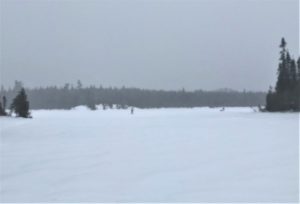 Off they went. But all went well. Hans left him near the rails, Pete made a lean-to…
Off they went. But all went well. Hans left him near the rails, Pete made a lean-to… 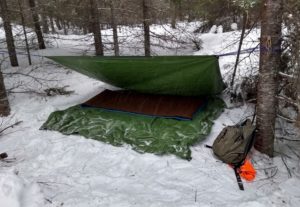 …slept well in his super-bag, even in the snow…
…slept well in his super-bag, even in the snow… 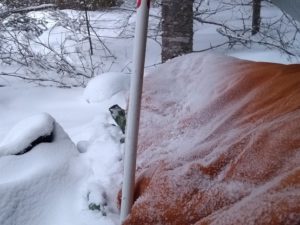 …flagged down the Budd Car next morning, and made it back south in time.
…flagged down the Budd Car next morning, and made it back south in time.
There were many small birds on this lake. A delightful surprise were White-Winged Crossbills, lovely things; the males bright red…  …and all quite tame. But in a slightly disgusting habit, they liked the frozen minerals (and sugars?) in our urine, and clustered around the pee-hole.
…and all quite tame. But in a slightly disgusting habit, they liked the frozen minerals (and sugars?) in our urine, and clustered around the pee-hole. 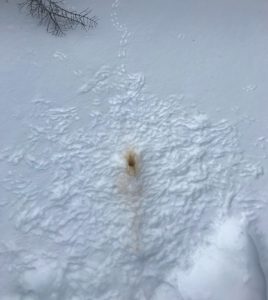 In fact we call them pee-peckers!
In fact we call them pee-peckers!
Day-Hikes: we bushwhacked in fresh snow for several hours to get to a lake on the map. Almost glorious, right? Almost spectacular!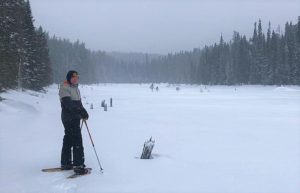
But some views were better than others. Phil is an artist, and came back into the tent and produced this. 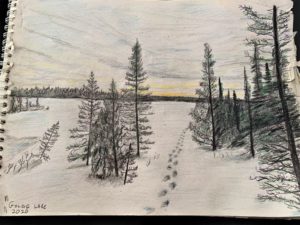 It had snowed lightly but continuously over the previous 3 days. The fly-sheet had done it’s job perfectly…
It had snowed lightly but continuously over the previous 3 days. The fly-sheet had done it’s job perfectly…  …and there were sizeable snow-banks beside the tent-walls, not pressing-in on them, or freezing the fabric to ice layers. By tying the tent underneath the ridgepole, and throwing the flysheet overtop, a separation layer ensures that the snow never lands on a warm surface…
…and there were sizeable snow-banks beside the tent-walls, not pressing-in on them, or freezing the fabric to ice layers. By tying the tent underneath the ridgepole, and throwing the flysheet overtop, a separation layer ensures that the snow never lands on a warm surface… 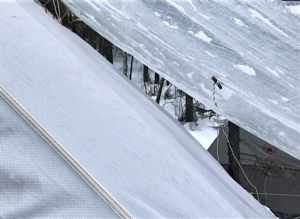 …thus never melts, thus slides off. In fact, in the above picture you can see the light nylon swelling upward, lifting like a hot-air balloon with the heat of the stove inside. A flysheet is a huge benefit to a wall-tent rig. Also, if you ever need to get camped quick-and-dirty, like if you were dropped off in the dark, you can use the flysheet alone to make a shelter — just put a tight line between 2 trees, throw the fly over, heap snow on the edges for a seal, wire the stove to 2 sticks on the snow at the front and the pipe to the tree, throw in your bedding, and go to sleep…
…thus never melts, thus slides off. In fact, in the above picture you can see the light nylon swelling upward, lifting like a hot-air balloon with the heat of the stove inside. A flysheet is a huge benefit to a wall-tent rig. Also, if you ever need to get camped quick-and-dirty, like if you were dropped off in the dark, you can use the flysheet alone to make a shelter — just put a tight line between 2 trees, throw the fly over, heap snow on the edges for a seal, wire the stove to 2 sticks on the snow at the front and the pipe to the tree, throw in your bedding, and go to sleep… 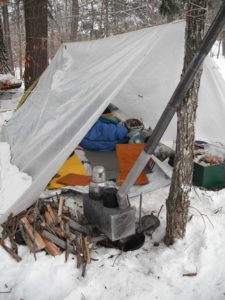 …as we did during this 2010 trip.
…as we did during this 2010 trip.
The Plan was to walk the long lake, find a trail over a height of land, get into the next lake, and get back to the track for pick-up, so we broke camp and hit the lake. Conditions were not perfect, but do-able — there was little slush, and we could both break-trail and tow sleds at the same time — but the 4″ of fresh powder lay on the lake in sculpted waves…  …and was nowhere near as slippery as the previous crust had been. For us it was a “grunt”. Snowshoes were required, and each step was a pull on the lines — not much gliding. The wind was behind us and the view…
…and was nowhere near as slippery as the previous crust had been. For us it was a “grunt”. Snowshoes were required, and each step was a pull on the lines — not much gliding. The wind was behind us and the view… 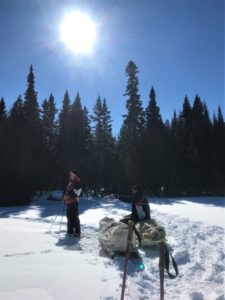 …was glorious, but I was very glad I’d prepared for this trip by skiing, snowshoeing at home, and a stair-walker every other day for months.
…was glorious, but I was very glad I’d prepared for this trip by skiing, snowshoeing at home, and a stair-walker every other day for months.
Over the decades, I’ve tried every kind of sled you can imagine. I’ve done comparative pull-tests on open untouched snow, using several people to remove bias, and several kinds of trail-packing such as different snowshoe designs, and even skis. Results:
- Pelican kids’ toboggan.
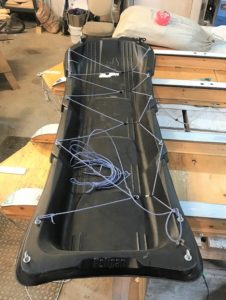 This has become my favourite; they are so lightweight, and pull easily in all kinds of snow. One is too short of course, so you have to string 2 together. (NOTE: double-stacking a load is a poor idea. Your sled tips-over and tows too hard. It’s better to tow 2 of them, single-stacked.) When going up hills, it is great to halve the load by pulling only 1 sled, and the light weight of the unit itself means you aren’t lugging a heavy structure against gravity. (I’ll be detailing how to modify these for trip-use in a separate article on this site.) A 6×8 poly tarp is a completely adequate containment, especially with the cross-hook arrangement I’ve developed. (Don’t get the Pelican sleds designed to be pulled by a ski-do — they are too wide for a snowshoe trail, and harder to pull.)
This has become my favourite; they are so lightweight, and pull easily in all kinds of snow. One is too short of course, so you have to string 2 together. (NOTE: double-stacking a load is a poor idea. Your sled tips-over and tows too hard. It’s better to tow 2 of them, single-stacked.) When going up hills, it is great to halve the load by pulling only 1 sled, and the light weight of the unit itself means you aren’t lugging a heavy structure against gravity. (I’ll be detailing how to modify these for trip-use in a separate article on this site.) A 6×8 poly tarp is a completely adequate containment, especially with the cross-hook arrangement I’ve developed. (Don’t get the Pelican sleds designed to be pulled by a ski-do — they are too wide for a snowshoe trail, and harder to pull.) - Ski-sleds. Terrific units! They pull so easily across a lake. BUT… you have to build them long and narrow.
 Find the longest old downhill skis you can, in your parent’s garage or wherever. And the sled must be narrow to pull well in a single snowshoe track. Then build them lightweight! Be a fanatic about it. Cedar, thin high-grade multi-layer plywood. Skis are designed to support a 220-lb person, sometimes on one ski, and in sled use there is rarely more than 100 lbs on them, usually less, and both skis are in contact. Thus they have more floatation than you think. The only downside is pulling one up a steep portage hill. The weight of the sled itself is against you.
Find the longest old downhill skis you can, in your parent’s garage or wherever. And the sled must be narrow to pull well in a single snowshoe track. Then build them lightweight! Be a fanatic about it. Cedar, thin high-grade multi-layer plywood. Skis are designed to support a 220-lb person, sometimes on one ski, and in sled use there is rarely more than 100 lbs on them, usually less, and both skis are in contact. Thus they have more floatation than you think. The only downside is pulling one up a steep portage hill. The weight of the sled itself is against you. - Pulks. I have a US Army surplus pulk that resembles a ski-patrol sled used to bring broken-legged skiers down hills. It’s a good unit.
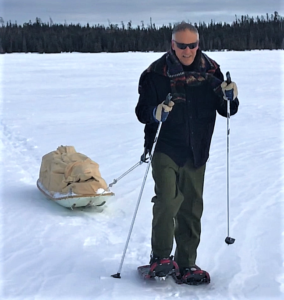 The picture makes it look short — but it’s over 6 ft long. Three runners along the bottom lift the hull out of the snow if there is any kind of a snow-pack at all. But the fiberglass body is a little heavy when you’re going uphill.
The picture makes it look short — but it’s over 6 ft long. Three runners along the bottom lift the hull out of the snow if there is any kind of a snow-pack at all. But the fiberglass body is a little heavy when you’re going uphill. - Cree-style toboggans. This is my LEAST-FAVOURITE unit. I used one a lot in my early trips. In this 1989 photo I was still experimenting.
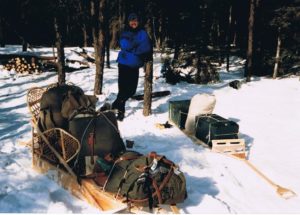 The problem is that the whole thing is in contact with the snow all the time, which adds drag. The idea of course is that in deep soft snow this will deliver lots of floatation, and will not dig in. But in real-life you are always pulling in at least one snowshoe track, maybe more, and in my field-test in deep snow with only one snowshoe-pack the ski-sleds and the pulk were easier to pull. Also, toboggans gain weight too easily during use by having snow wedge into every opening and gap. There’s not much point in going lightweight if 50 lbs of snow joins your load. I made mine from High-Density-Polyethylene for low friction, but it still wasn’t as easy to pull as the others.
The problem is that the whole thing is in contact with the snow all the time, which adds drag. The idea of course is that in deep soft snow this will deliver lots of floatation, and will not dig in. But in real-life you are always pulling in at least one snowshoe track, maybe more, and in my field-test in deep snow with only one snowshoe-pack the ski-sleds and the pulk were easier to pull. Also, toboggans gain weight too easily during use by having snow wedge into every opening and gap. There’s not much point in going lightweight if 50 lbs of snow joins your load. I made mine from High-Density-Polyethylene for low friction, but it still wasn’t as easy to pull as the others. - Containment — this is critical! You must have a fabric cover of some sort.
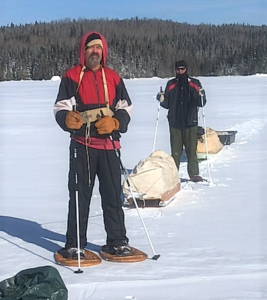 It reduces weight 2 ways: it stops snow from lodging into every corner and crevice of your load as you pull, and it functions as a giant pack-sack. Backpacks are heavy! On these trips you don’t need canoe-packs or other heavy duffel bags. The sled-cover is enough. The best pack I use is a clear plastic garbage bag — it weighs nothing and you can see where your stuff is. (Never put anything but garbage in a green plastic bag — guess how I know this!) I also use simple cardboard boxes for storing camp-gear on the sleds.
It reduces weight 2 ways: it stops snow from lodging into every corner and crevice of your load as you pull, and it functions as a giant pack-sack. Backpacks are heavy! On these trips you don’t need canoe-packs or other heavy duffel bags. The sled-cover is enough. The best pack I use is a clear plastic garbage bag — it weighs nothing and you can see where your stuff is. (Never put anything but garbage in a green plastic bag — guess how I know this!) I also use simple cardboard boxes for storing camp-gear on the sleds. 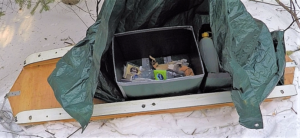 These are MUCH better than plastic tubs because they are very lightweight, and waste no space (tubs are designed to stack when empty, and waste room on the sled). I paint the cardboard boxes with oil paint, and reinforce their edges with duct-tape. Since it’s winter and it doesn’t rain where I go, they last well. In the picture, they are being stored for the night — the sled is inverted to keep the runners clear of ice, the box is set between the skis, and a tarp is thrown over in case it snows. Again: on this trip I used no traditional pack-sacks at all.
These are MUCH better than plastic tubs because they are very lightweight, and waste no space (tubs are designed to stack when empty, and waste room on the sled). I paint the cardboard boxes with oil paint, and reinforce their edges with duct-tape. Since it’s winter and it doesn’t rain where I go, they last well. In the picture, they are being stored for the night — the sled is inverted to keep the runners clear of ice, the box is set between the skis, and a tarp is thrown over in case it snows. Again: on this trip I used no traditional pack-sacks at all.
Anyway, it was a long tiring day on the ice. Sometimes the wind blew the fresh snow clear, and we were on the old hard-pack. Easy! Wonderful! But it never lasted more than about 20 ft. We met with no troubles at the various narrows on the lake, where currents might have thinned the ice…  … but we examined the snow for signs of weakness with great attention. The -20C of the previous 3 days had helped I guess. However we’ve had MUCH worse on past trips. Any time you can pull your load and break trail at the same time, conditions are good. Frequent stops help…
… but we examined the snow for signs of weakness with great attention. The -20C of the previous 3 days had helped I guess. However we’ve had MUCH worse on past trips. Any time you can pull your load and break trail at the same time, conditions are good. Frequent stops help…  …and it’s useful to hand out hard candies before the pulling starts. It’s surprising how long you can keep a peppermint in your cheek as you walk!
…and it’s useful to hand out hard candies before the pulling starts. It’s surprising how long you can keep a peppermint in your cheek as you walk!
We found a decent spot to camp…  …which we planned for 2 nights — tomorrow we’d find the trail to the new lake, and the next day move across it. This site was under the trees a bit more, and we noticed at breakfast how practical it was to have the fly-sheet made of clear (white-ish) material, and the bulk of the tent of the white rip-stop nylon. Very bright inside…
…which we planned for 2 nights — tomorrow we’d find the trail to the new lake, and the next day move across it. This site was under the trees a bit more, and we noticed at breakfast how practical it was to have the fly-sheet made of clear (white-ish) material, and the bulk of the tent of the white rip-stop nylon. Very bright inside… 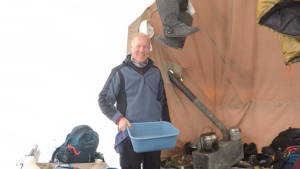 …when if the fabric choices had been different, we’d have had headlamps on even in daylight.
…when if the fabric choices had been different, we’d have had headlamps on even in daylight.
There was no trail marked on any map. Yet every time in the past I have wanted to get from one lake to another, I’ve found one. People have been moving in the Bush for a long time. Usually there is a trail. And… drum-roll… ta-da! — we found one. It took a bit of sleuthing because of course we were walking 2 ft or more above the ground, but we found it, and since it went up onto higher terrain, away from the alders and tangles, it only needed minimal clearing. The length was 1.2 km. Not easy. No one had been on it of course — there was no winter-sign of people anywhere during the trip. So it would be an effort. But I’d been curious about this route-possibility for a long time, and I was delighted to find the thing! Excellent feeling of accomplishment!  We carried on a bit into the new lake, and stopped for a quick lunch brew-up.
We carried on a bit into the new lake, and stopped for a quick lunch brew-up.  It’s amazing how fast you can boil a teapot if you stop in the right place! We relished the hot liquid — all of us were a thirsty after the trail work. And sandwiches taste better toasted.
It’s amazing how fast you can boil a teapot if you stop in the right place! We relished the hot liquid — all of us were a thirsty after the trail work. And sandwiches taste better toasted.
Next, Phil went back to bring a first load of non-essentials over the trail, and Sion and I pushed on to survey conditions on the new lake. Not so good, really. Too warm. This would turn out to be the highest temperature of the trip: about +3C in the late afternoon. The snow got sticky, and balled-up under the modern snowshoes. My traditional Cree shapes, re-strung with monofilament by David Marrone at Lure Of The North, were clearly the best — immune to moisture, and a simple twist of my boot mostly removed the build-up. 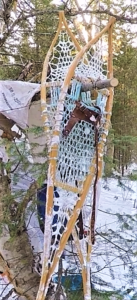 Phil had up to 5″ of ice attach itself under the crampons of his shoes.
Phil had up to 5″ of ice attach itself under the crampons of his shoes. 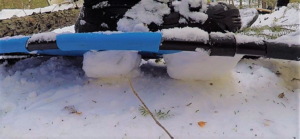 Everyone else complained too.
Everyone else complained too.
Anyway, Sion and I found a spot for the next camp, and cut a ridgepole and cleared some underbrush. This is a great way to expedite wall-tent camping. Then we went exploring the lake. There was a narrow neck of land that intrigued me. I wondered… was there another portage? It would save 2 km of lake-walking by cutting-off a large peninsula. So we headed over there… but then I stopped. There were pockets of slush, and too many otter-holes. The bay was marshy, and marshes generate their own heat. My bush-sense was screaming at me. We turned around. Pulling for an extra 2 km is not fun, but it’s also not too challenging if the snow is hard. Better than swimming in snowshoes.
Next morning we were up early, broke camp, and hit the portage. Thankfully it was cooler, well below freezing. The loads were a hard heave on the uphill grade… 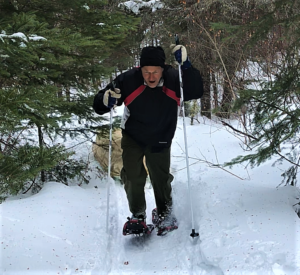 …but as for me I pulled only one Pelican sled at a time. Much easier! In fact, I quite enjoyed the walk back to get the other sled. It’s like what Bill Mason said about portaging — the walk back is like NOT hitting yourself in the head with a hammer. And having packed the trail down the previous day, and with a good freeze overnight, it was all a bit easier than expected. In a couple of hours all our loads were across, and away down the new lake we went.
…but as for me I pulled only one Pelican sled at a time. Much easier! In fact, I quite enjoyed the walk back to get the other sled. It’s like what Bill Mason said about portaging — the walk back is like NOT hitting yourself in the head with a hammer. And having packed the trail down the previous day, and with a good freeze overnight, it was all a bit easier than expected. In a couple of hours all our loads were across, and away down the new lake we went. 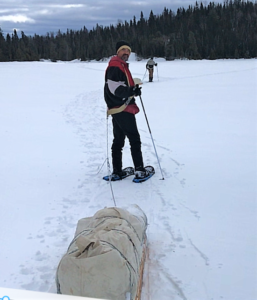 The new camp went up quickly courtesy of yesterday’s prep. Heat was available in short order.
The new camp went up quickly courtesy of yesterday’s prep. Heat was available in short order.  And it’s a good thing I didn’t dig out the footwell any deeper.
And it’s a good thing I didn’t dig out the footwell any deeper. 
Next morning, on the trail again, this time to the last camp, hauling was not too bad — Hans and Sion had pre-packed most of the trail the evening before while Phil and I did the camp-chores. Walk and pull, walk and pull… 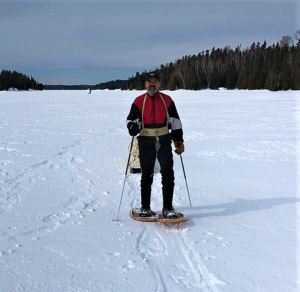 We were looking for a spot to camp about a half-km from the track so we’d get to the train by 09:30 next morning. With the tracks in sight, the pressure was off.
We were looking for a spot to camp about a half-km from the track so we’d get to the train by 09:30 next morning. With the tracks in sight, the pressure was off. 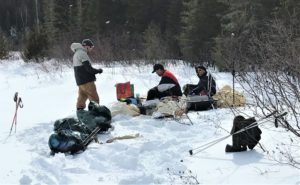 We’d made the right place, on the right day. One last fine camp,
We’d made the right place, on the right day. One last fine camp,  and wall-tent-evening,
and wall-tent-evening, 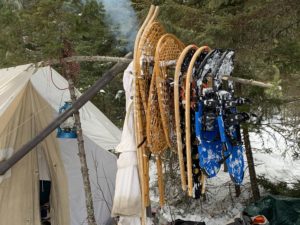 and we finished off the last of the rum — time for the train!
and we finished off the last of the rum — time for the train!
A quick breakfast of oatmeal and bacon, everything onto the sleds, and we were away by 08:00 next morning.  All set up by the rails. We’d put highly-coloured packs upstream for the engineer to see, to warn him we were there,
All set up by the rails. We’d put highly-coloured packs upstream for the engineer to see, to warn him we were there,  and we sat down to wait. And wait.
and we sat down to wait. And wait.  And wait. There had been native protests about pipelines in the news when we left. We didn’t know if the Budd Car was going to run or not. And the ETA came… and went… and went… Snow fell in steady showers. I took a sled tarp and set up a shelter.
And wait. There had been native protests about pipelines in the news when we left. We didn’t know if the Budd Car was going to run or not. And the ETA came… and went… and went… Snow fell in steady showers. I took a sled tarp and set up a shelter. 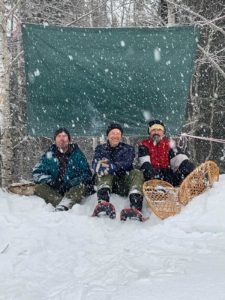 A freight went by — good news, the tracks were at least open! But no train for us. I smoked a last good one,
A freight went by — good news, the tracks were at least open! But no train for us. I smoked a last good one, 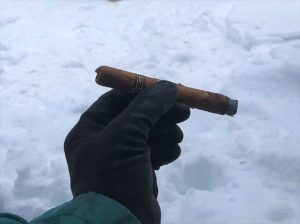 and tried not to watch the clock. Then, an hour later, a freight train slowed down as it passed, and the engineer hollered to us, “The Budd Car’s been derailed, at Missinaibi. It’s gonna be late!” Which prompted Phil to get busy and make a more formal shelter using the flysheet…
and tried not to watch the clock. Then, an hour later, a freight train slowed down as it passed, and the engineer hollered to us, “The Budd Car’s been derailed, at Missinaibi. It’s gonna be late!” Which prompted Phil to get busy and make a more formal shelter using the flysheet… 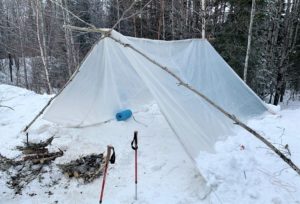 …and setting up a fire on bedlogs in the snow.
…and setting up a fire on bedlogs in the snow. 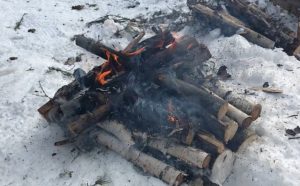 Then another freight train came around the bend — and this time it stopped! Completely! Just to talk to us! The engineer explained that the Budd Car service was cancelled for the day but they were going to take us out on a maintenance vehicle. What tremendous concern for us! We felt honoured. And after a while a guy pulls in in one of those pickup-trucks that have rail-wheels underneath, and says, “You guys looking for a ride?” And we folded up the tarp, loaded up…
Then another freight train came around the bend — and this time it stopped! Completely! Just to talk to us! The engineer explained that the Budd Car service was cancelled for the day but they were going to take us out on a maintenance vehicle. What tremendous concern for us! We felt honoured. And after a while a guy pulls in in one of those pickup-trucks that have rail-wheels underneath, and says, “You guys looking for a ride?” And we folded up the tarp, loaded up… 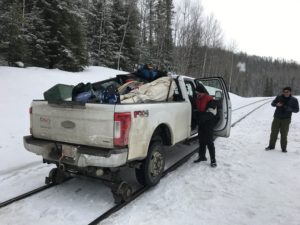 …and rode away in style! Limo service!
…and rode away in style! Limo service!  I’ve owned a pickup truck for most of my life, but this was a unique perspective:
I’ve owned a pickup truck for most of my life, but this was a unique perspective: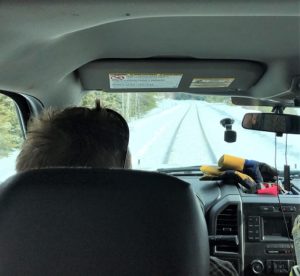 The driver, Jordan C, a nice guy, was on his way out anyway to go on vacation, and he dropped us off at the train station in Chapleau. Well, to shorten the story, ViaRail looked after us superbly. They booked us rooms in the Chapleau Inn, quite modern and nice. And we even borrowed a pickup truck from Al, a friend of Jean-Guy (a retired Conductor we’d met years before on trips). Al tossed us the keys and said, “Leave it at the train station in the morning.” Thanks Al! Northern hospitality!
The driver, Jordan C, a nice guy, was on his way out anyway to go on vacation, and he dropped us off at the train station in Chapleau. Well, to shorten the story, ViaRail looked after us superbly. They booked us rooms in the Chapleau Inn, quite modern and nice. And we even borrowed a pickup truck from Al, a friend of Jean-Guy (a retired Conductor we’d met years before on trips). Al tossed us the keys and said, “Leave it at the train station in the morning.” Thanks Al! Northern hospitality!
And then we drove to a diner and pigged-out on beer and burgers, 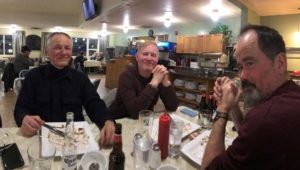 exactly as you always want to do when you come out of the Bush.
exactly as you always want to do when you come out of the Bush.
The Budd Car had not really been “de-railed” except technically. We got the story: when it went onto a siding to make room for a freight to come through (it’s a single-track section), the baggage car, empty and very light, rode up in some compacted snow at a road crossing and simply wandered off the rails.  Usually a heavy freight train deals with snow and ice in that situation but there hadn’t been one on that particular siding track in a while. So the Budd Car passenger car eventually de-coupled and got back onto the route, but by then the crew were over their duty-time, and had to layover in Chapleau. We hopped-on next morning, and had a private rail car all the way to Sudbury! Breakfast was First-Class, right out of the grub-box…
Usually a heavy freight train deals with snow and ice in that situation but there hadn’t been one on that particular siding track in a while. So the Budd Car passenger car eventually de-coupled and got back onto the route, but by then the crew were over their duty-time, and had to layover in Chapleau. We hopped-on next morning, and had a private rail car all the way to Sudbury! Breakfast was First-Class, right out of the grub-box… 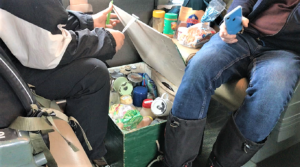 …eating all the good stuff we’d been hoarding. We nibbled for the entire ride.
…eating all the good stuff we’d been hoarding. We nibbled for the entire ride. 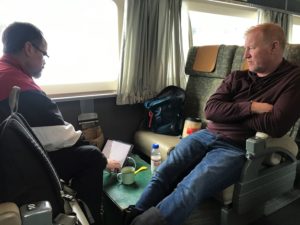 And charged batteries. Speeding on across the Bush, we made the run in record time, and by 14:00 were in Sudbury. My truck was still there — it started! — and by 17:00 we were back at my place, toasting our success!
And charged batteries. Speeding on across the Bush, we made the run in record time, and by 14:00 were in Sudbury. My truck was still there — it started! — and by 17:00 we were back at my place, toasting our success! 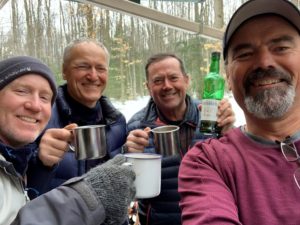 What a great trip. Three of us were over 60, yet a stronger healthier more congenial and collegial group of guys you couldn’t find. Great companions, and another great adventure.
What a great trip. Three of us were over 60, yet a stronger healthier more congenial and collegial group of guys you couldn’t find. Great companions, and another great adventure.
